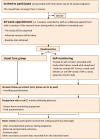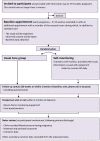Blood pressure monitoring in high-risk pregnancy to improve the detection and monitoring of hypertension (the BUMP 1 and 2 trials): protocol for two linked randomised controlled trials
- PMID: 31980512
- PMCID: PMC7044851
- DOI: 10.1136/bmjopen-2019-034593
Blood pressure monitoring in high-risk pregnancy to improve the detection and monitoring of hypertension (the BUMP 1 and 2 trials): protocol for two linked randomised controlled trials
Erratum in
-
Correction: Blood pressure monitoring in high risk pregnancy to improve the detection and monitoring of hypertension (The BUMP 1&2 trials): protocol for two linked randomised controlled trials.BMJ Open. 2020 Aug 27;10(8):e034593corr1. doi: 10.1136/bmjopen-2019-034593corr1. BMJ Open. 2020. PMID: 32859668 Free PMC article. No abstract available.
Abstract
Introduction: Self-monitoring of blood pressure (BP) in pregnancy could improve the detection and management of pregnancy hypertension, while also empowering and engaging women in their own care. Two linked trials aim to evaluate whether BP self-monitoring in pregnancy improves the detection of raised BP during higher risk pregnancies (BUMP 1) and whether self-monitoring reduces systolic BP during hypertensive pregnancy (BUMP 2).
Methods and analyses: Both are multicentre, non-masked, parallel group, randomised controlled trials. Participants will be randomised to self-monitoring with telemonitoring or usual care. BUMP 1 will recruit a minimum of 2262 pregnant women at higher risk of pregnancy hypertension and BUMP 2 will recruit a minimum of 512 pregnant women with either gestational or chronic hypertension. The BUMP 1 primary outcome is the time to the first recording of raised BP by a healthcare professional. The BUMP 2 primary outcome is mean systolic BP between baseline and delivery recorded by healthcare professionals. Other outcomes will include maternal and perinatal outcomes, quality of life and adverse events. An economic evaluation of BP self-monitoring in addition to usual care compared with usual care alone will be assessed across both study populations within trial and with modelling to estimate long-term cost-effectiveness. A linked process evaluation will combine quantitative and qualitative data to examine how BP self-monitoring in pregnancy is implemented and accepted in both daily life and routine clinical practice.
Ethics and dissemination: The trials have been approved by a Research Ethics Committee (17/WM/0241) and relevant research authorities. They will be published in peer-reviewed journals and presented at national and international conferences. If shown to be effective, BP self-monitoring would be applicable to a large population of pregnant women.
Trial registration number: NCT03334149.
Keywords: blood pressure; gestational hypertension; hypertension; pre-eclampsia; pregnancy; self-monitoring.
© Author(s) (or their employer(s)) 2020. Re-use permitted under CC BY. Published by BMJ.
Conflict of interest statement
Competing interests: RJM has previously received BP monitors from Omron for research purposes. The BP monitors for the current trials were purchased from the manufacturer (Microlife) at commercial prices.
Figures





References
-
- Cantwell R, Clutton-Brock T, Cooper G, et al. . Saving mothers' lives: reviewing maternal deaths to make motherhood safer: 2006-2008. The eighth report of the Confidential enquiries into maternal deaths in the United Kingdom. BJOG 2011;118 Suppl 1:1–203. 10.1111/j.1471-0528.2010.02847.x - DOI - PubMed
-
- Knight M, Tuffnell D, Kenyon S. Saving lives, improving mothers' care: surveillance of maternal deaths in the UK 2011-13 and lessons learned to inform maternity care from the UK and Ireland. confidential enquiries into maternal deaths and morbidity 2009-13. National Perinatal Epidemiology Unit, University of Oxford, 2015.
Publication types
MeSH terms
Associated data
Grants and funding
LinkOut - more resources
Full Text Sources
Medical
